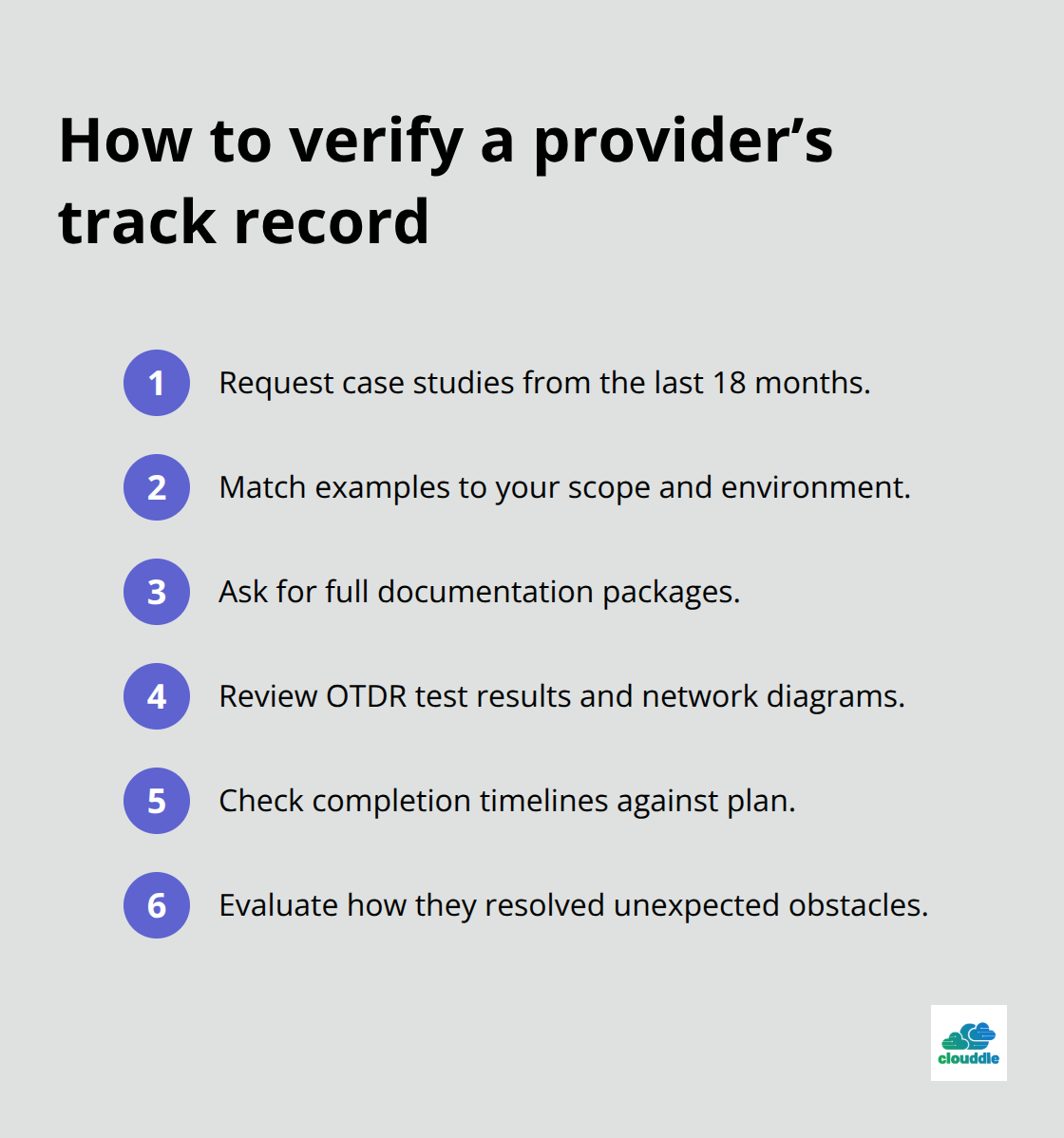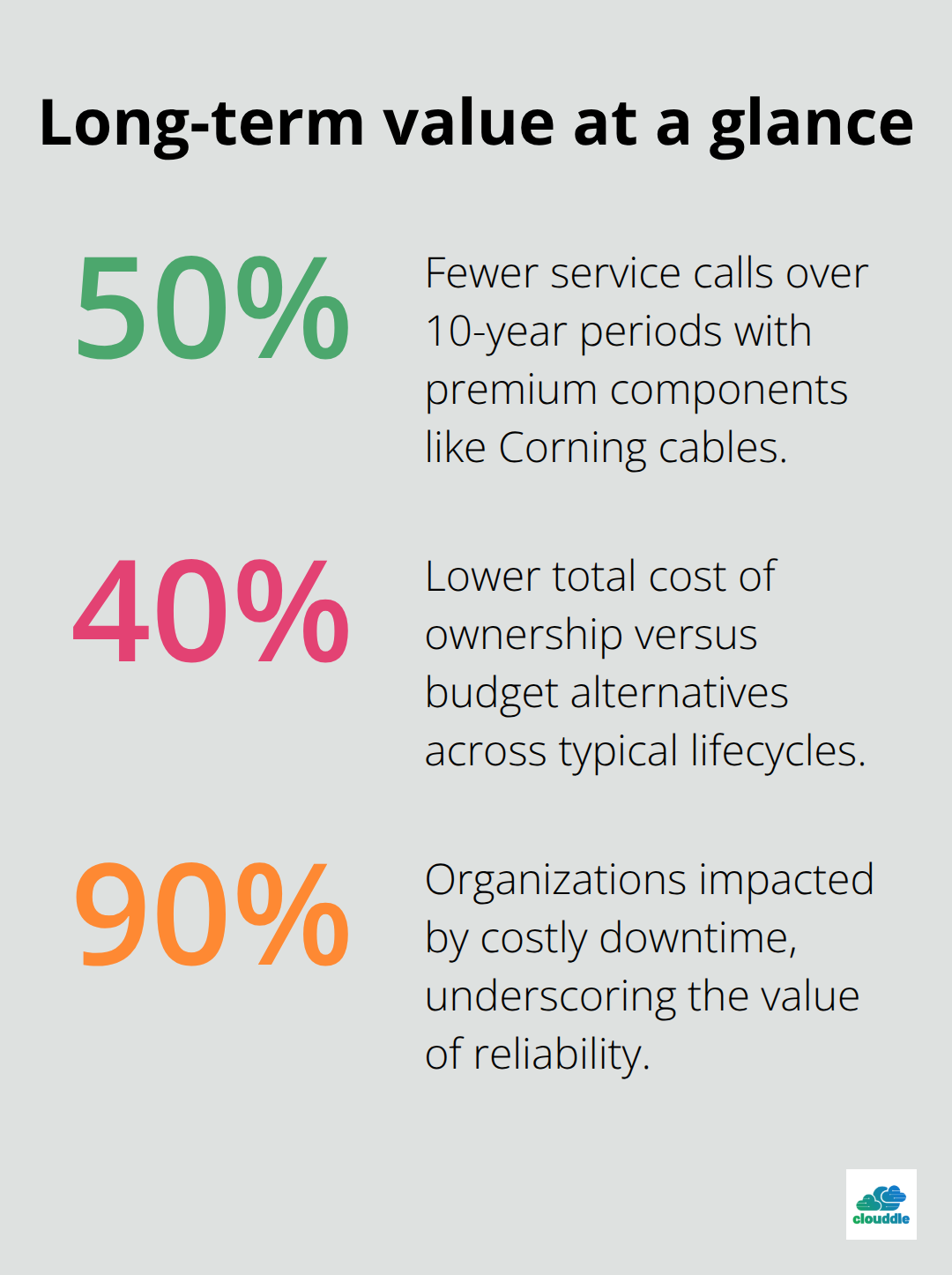Businesses upgrading their network infrastructure face a critical decision when selecting fiber optic cable installation services. The wrong choice can lead to costly delays, poor performance, and ongoing maintenance issues.
We at Clouddle understand that finding qualified installers requires careful evaluation of multiple factors. This guide breaks down the essential criteria for choosing installation partners who deliver reliable, long-term network solutions.
What Makes a Qualified Fiber Installation Team
The technical complexity of fiber optic networks demands installers with proven expertise in both modern and legacy systems. Look for contractors who have completed at least 100 commercial installations over the past three years, as this volume indicates consistent project delivery and problem-solving experience. The Fiber Optic Association reports that 28,000 additional broadband construction workers and 30,000 technicians are needed to meet current demand, which makes experienced teams increasingly valuable. Contractors should demonstrate proficiency with advanced techniques like fusion splicing, OTDR testing, and both underground directional drilling and aerial installation methods.
Certifications That Actually Matter
Industry certifications separate qualified installers from general contractors who attempt fiber work. Fiber Optic Association FOA certification and BICSI credentials represent the gold standard for technical competency. These programs require hands-on training with real equipment and testing scenarios that mirror actual installation challenges. Contractors certified by these organizations understand proper cable handling, bend radius requirements, and signal testing protocols that prevent costly rework.

Additionally, verify that installers hold current safety certifications for work with underground utilities and aerial installations, as regulatory compliance failures can halt projects indefinitely.
Equipment Standards and Testing Capabilities
Professional fiber installers invest in quality equipment that directly impacts installation success. Contractors should own fusion splicers from manufacturers like Fujikura or Sumitomo, OTDR testing equipment for signal verification, and proper cable pulling systems that prevent damage during installation. Corning fiber optic cables have become the preferred choice for commercial installations due to their exceptional durability ratings. Ask potential contractors about their testing procedures and equipment calibration schedules, as outdated or poorly maintained tools produce unreliable results that compromise network performance.
Project Portfolio and Reference Verification
Experienced contractors maintain detailed portfolios that showcase their installation capabilities across different environments. Request examples of similar projects in your industry (hospitality, multi-family dwelling, or senior living facilities) to assess their relevant experience. Contact at least three recent clients to verify project completion times, quality standards, and post-installation support. The best installers provide comprehensive documentation including network diagrams, test results, and maintenance schedules that demonstrate their systematic approach to complex installations.
How Do You Verify a Service Provider’s Track Record
Professional fiber installers demonstrate their capabilities through comprehensive project documentation that extends far beyond basic portfolio presentations. Request detailed case studies from installations completed within the past 18 months, with specific focus on projects similar to your scope and environment.

The strongest contractors provide network diagrams, OTDR test results, and completion timelines that reveal their systematic approach to complex installations. Look for providers who document their problem-solving processes, including how they handled unexpected obstacles like utility conflicts or environmental challenges during underground installations.
Response Standards That Matter
Service availability directly impacts your network uptime and business operations. Top-tier installers guarantee response times for emergency service calls and provide dedicated project managers who maintain communication throughout installation phases. Skilled technician availability has become a competitive advantage, which makes responsive support teams increasingly valuable. Contractors should offer multiple communication channels including direct phone access to technical staff, not just customer service representatives. Verify that emergency support includes actual technicians with fiber expertise, not general IT support staff who lack specialized knowledge.
Warranty Terms That Protect Your Investment
Installation warranties vary dramatically between providers, with quality contractors offering comprehensive coverage that extends beyond basic workmanship guarantees. Professional installers provide minimum 5-year warranties on fusion splices and 10-year coverage on cable installations, backed by detailed documentation of all connection points and test results. The warranty should include both labor and materials replacement, plus performance guarantees that specify minimum signal strength levels (typically -20 dBm or better for single-mode fiber). Avoid contractors who offer only 1-year warranties, as this indicates either inexperience or low-quality materials that require frequent repairs.
Maintenance Agreements and Ongoing Support
Maintenance agreements should include annual OTDR testing, connector cleaning, and proactive monitoring services that identify potential issues before they cause network failures. Quality providers offer structured maintenance programs with scheduled inspections every 6-12 months, depending on your environment and usage patterns. These programs typically cost 10-15% of the initial installation value annually but prevent costly emergency repairs and network downtime. The best maintenance contracts include priority response times and discounted rates for additional services or network expansions.
Understanding these verification criteria helps you identify qualified installers, but the financial aspects of your decision require equally careful consideration.
What Should Fiber Installation Actually Cost
Professional fiber optic installations typically range from $3-8 per linear foot for standard commercial runs, but the total project cost depends heavily on complexity factors that many contractors obscure in initial quotes. Underground directional drilling adds $15-25 per foot, while aerial installations cost $8-12 per foot (including pole attachment fees). Quality contractors provide itemized estimates that separate materials, labor, testing, and permit costs rather than bundle everything into vague line items.
Demand detailed breakdowns that specify cable types, connector quantities, and testing procedures, as these components represent 60-70% of total project expenses. Contractors who refuse to provide transparent pricing typically add 20-30% markup through hidden fees for basic services like equipment setup or final testing.
Service Level Agreements That Actually Work
Effective service agreements specify measurable performance standards rather than generic uptime promises that provide no recourse when problems occur. Professional installers guarantee network availability of 99.9% or higher, with specific penalty clauses that reduce monthly fees when performance falls below agreed thresholds.
Response time commitments should differentiate between business hours and emergency scenarios, with quality providers offering 4-hour response for critical failures and 24-hour resolution targets. Contract terms longer than 3 years typically offer 15-20% cost savings but require careful evaluation of technology refresh provisions, as fiber equipment advances rapidly.
Hidden Fees That Inflate Project Costs
Many contractors add unexpected charges after project approval, which can increase total costs by 25-40% beyond initial estimates. Common hidden fees include permit application costs, utility coordination charges, and equipment rental fees that should be included in base pricing. Professional installers disclose all potential additional costs upfront and provide fixed-price contracts that protect against scope creep.
Watch for contractors who quote unusually low initial prices but charge premium rates for “unforeseen circumstances” that experienced installers anticipate during proper site surveys. Quality providers conduct thorough site assessments and include contingency allowances for typical installation challenges.
Long-term Value Beyond Installation Costs
Quality fiber installations deliver measurable returns through reduced maintenance expenses and improved operational efficiency that justify higher upfront investment. Professional installations using premium components like Corning cables typically require 50% fewer service calls over 10-year periods compared to budget installations.
Network downtime costs businesses over $300,000 per hour for over 90% of organizations, which makes reliable installation practices worth significant premium pricing. Factor in scalability benefits when evaluating proposals, as properly designed fiber networks support bandwidth increases through advanced data transmission capabilities. The total cost of ownership for professional installations averages 40% lower than budget alternatives when calculated over typical equipment lifecycles.

Final Thoughts
Professional fiber optic cable installation services require careful evaluation of technical expertise, certifications, and proven project portfolios that demonstrate consistent quality delivery. Contractors with FOA certification, advanced test equipment, and transparent pricing structures protect your investment through comprehensive warranties and responsive support services. The decision impacts your network performance for decades, which makes qualified contractors worth premium pricing compared to budget alternatives that often result in costly repairs and downtime.
Quality installations with professional-grade components deliver 40% lower total ownership costs while they support future bandwidth requirements. Professional installers understand proper cable handling, bend radius requirements, and signal test protocols that prevent costly rework. These installations typically require 50% fewer service calls over 10-year periods compared to budget installations.
Businesses in hospitality, multi-family dwelling, and senior living sectors need reliable technology partners who understand their unique requirements. Clouddle provides comprehensive technology solutions that combine installation expertise with ongoing support through their Network as a Service model. This approach eliminates upfront investment while it provides 24/7 customer service and flexible contract terms that adapt to operational needs.


